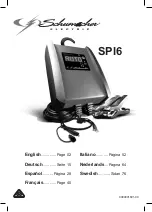
6
WARNING!
This product shall only be installed,
repaired or serviced by an authorised
electrician. All applicable local, regional and
national regulations for electrical installations
must be respected.
Prior to the installation, it is important that you consider
present and future charging needs, so that you can
easily expand accordingly in the future.
If several Charging Robots are used on one circuit, the
total current is dynamically distributed between the
connected Charging Robots. The connected Charging
Robots communicate via radio signal with the main unit,
thus ensuring that the specified total charging current
of the charging infrastructure is not exceeded. The
maximum charging current is set during configuration.
Check the following before starting the installation
— Where should the Easee Ready be installed?
— Is the connected electrical load of the building
sufficient or does it need to be increased? Does a
new cable have to be laid? (An external approval may
be required). Should the incoming supply cable be
upgraded?
— How is the electrical circuit protected?
— Which installation method is planned to be used?
Planning the
installation
Pay attention to the following when planning the
installation
— The correct selection of the grounding/earthing
system, conductors and protective measures (basic
protection/ fault protection).
— The correct insulation of touchable and conductive parts.
— Sufficient dimensioning of cables and lines.
— The selection of the overcurrent and overvoltage
protection.
— The correct calculation of the short-circuit current as
well as a short-circuit proof installation method.
Residual Current Device (RCD)
A Residual Current Device (RCD), according to EN 61008-1
and IEC 62955, is integrated in the Charging Robot. This
will switch off the current to the electrical vehicle if a
residual current of 4-6mA DC and/or 20-30mA AC occurs.
The RCD is reset by unplugging the charging cable and
plugging it in again. The integrated RCD is automatically
tested and calibrated at regular intervals by the Charging
Robot.
The integrated RCD has no influence on the function
of external protective devices. If a Class II installation
is supplying the Charging Robot(s), no external RCD is
normally required. Local wiring regulations must however
always be followed.
For an optimal result, we recommend that you do the
following
— We always recommend a 3 phase installation if
possible, to make it future-proof.
— If possible, use the largest approved cable cross-
section (see page 4).
Содержание Ready
Страница 1: ...Easee Ready User installation guide...
Страница 17: ...17...
Страница 18: ...18 Easee AS Grenseveien 19 4313 Sandnes Norway easee com...




































